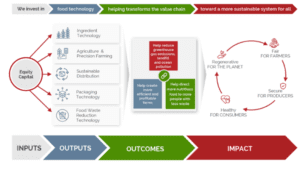Brad Jakeman & Rini Greenfield, Co-Founders & Managing Partners, Rethink Food
Excerpt from the June 2022 Newsletter
We continue to see an acceleration of the disruption and reinvention of the entire global food system. Led by disruptive founders, enabled by advanced digital technology, the food system is evolving to be more sustainable, nutritious and accessible at scale. The once “sleepy” commodity-oriented, built for scale industry is transforming to a personalized value-added global supply chain with much greater attention being paid to solving its negative impacts on the environment and food waste.
The disruption of the legacy food system represents exciting opportunities for tech-enabled founders and investors. In 2021 a total of $39.3BN was invested in FoodTechthrough 1,358 deals according to Pitchbook(1), double what it was in 2020. According to an analysis by Food Dive nine of the top ten funding rounds in food last year went to alternative protein and tech-enabled food companies(2). And, The tumultuous capital markets are also creating an opportunity for FoodTech investors. As capital becomes harder to come by, we expect to see some more rational multiples for exciting companies.
At the recent Future of Food-Tech conference in San Francisco in March, which Rini attended, many panels talked about this investment enthusiasm in FoodTech unlikely to wane any time soon, despite the uncertain capital market performance. Matt Spence, Partner with Guggenheim Partners, who was on a panel at the event made the point that FoodTech’s ability to help the planet in terms of sustainability and feeding the world’s growing population has expanded the investor interest in the sector.
As evidenced by five exciting investments we have made to date at Rethink Food, and our robust pipeline of potential companies, we believe this helps reinforce the attractiveness of the sector, and also our investment thesis and approach.

Earlier this year, the Chinese Ministry of Agriculture and Rural Affairs released its 14th Five-Year Agricultural Plan. This serves as a road map for the future of China’s food supply and a plan for agricultural and rural modernization. For the first time ever, the plan includes cultivated meat, as well as plant-based egg and meat alternatives, as a way to increase food security and sustainable agriculture. In China, cattle alone contributed almost 30% of the country’s agricultural emissions in 2014, the last year for which data is available. As the biggest source of greenhouse gases in the world, the country is now under pressure to find ways to reduce its impact on the planet and reducing meat consumption could help. We believe that this move will accelerate the country’s regulatory timeline for cultivated meat, and provide more focus overall on alternative proteins. As the country with one of the largest consumption of beef, pork, chicken and eggs, this is exciting news for investors in FoodTech, demonstrating a continued emphasis on alternative proteins.
The war in Ukraine has put the spotlight once again on global food insecurity, which continues to plague developed and emerging markets alike. Acute food insecurity is now at crisis levels in the United States, with close to 40 million people (12 million of which are children) being classified as food insecure. This represents a 20% increase since 2020, and is a particularly unconscionable situation given that at the same time, the US wastes more than one third of the food it produces. The urgency to address these fundamental issues has never been higher, and FoodTech represents the most optimistic, expeditious and likely solution.